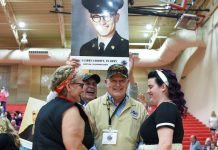It was an afternoon of remembrance.
The reasons were varied, but the inspiration for each of the participants in Sunday’s Walk to End Alzheimer’s was the same — to honor those who have lost their lives to Alzheimer’s, and to find a way to eradicate the disease for good.
“It’s a really great time to bring people together who have lost loved ones to Alzheimer’s, or are caregivers,” said Linda Altmeyer, director of programs for the Greater Indiana Chapter of the Alzheimer’s Association.
“They feel like they’re part of a movement.”
[sc:text-divider text-divider-title=”Story continues below gallery” ]
About 450 people came together Sunday in Mill Race Park to join the movement to end Alzheimer’s, bringing in an estimated $75,000 to $80,000 to support the Alzheimer’s Associations’ various resources and programs.
People from all walks of lives — including those whose families are affected by the disease or those who simply want to show their support — joined together to walk either a one- or three-mile route around the park.
“Any little thing you can do to help, I think it’s worth it,” said Pam Hackstadt, who walked on behalf of her friend whose father is living with Alzheimer’s.
As the crowd moved through Columbus, each person carried a flower with a specific color that represented their purpose for being there. The flowers were:
Purple for a loved one who was lost to the disease
Yellow for caregivers
Orange to show solidarity who those affected by Alzheimer’s
Blue for those currently suffering from the symptoms of Alzheimer’s or dementia
Before the walk began, participants raised their flowers one color at a time in a special Promise Garden Ceremony to remind each other of the reason behind their actions.
“It’s a really cool thing to experience,” said Daniel Pearson, spokesperson for the Greater Indiana Alzheimer’s Association. “It’s really powerful.”
And as the walkers wound their way through Mill Race Park, they continued to raise their flowers high as a constant reminder of the work that needs to be done to spare families the heartbreak of slowly losing a loved one.
“It’s just a terrible disease,” said MaryBeth Piland, who walked with other caregivers who represented the Morning Pointe Assisted Living Center in Franklin.
Morning Pointe has an Alzheimer’s unit, Piland said, so she sees the struggles and heartbreaks families endure daily when a loved one can no longer remember those they once held dear.
“They’re no longer the mother and father you once had,” she said.
But Piland refuses to give up hope that one day a care for Alzheimer’s will be found, so she has participated in the Columbus Walk to End Alzheimer’s every year for eight years.
And as she made her way on the one-mile route with her coworkers, Piland shared her hope for the future of her patients by singing songs to cheer on the other walkers and raising her yellow flower high.
Though appreciated, Piland’s enthusiasm was countered by other walkers who are numb from the pain of a loved one forgetting them, even after their death.
Marilyn Richards, whose mother-in-law died from Alzheimer’s, can still recall the sting her husband felt when his mother began accusing him of acting out of character.
“She thought he had done some really bad things, and my husband has never done anything bad in his life,” Richards said. “It hurts.”
And the situation is no worse from a distance, Hackstadt said.
Her friend’s father does not live near his daughter, which means each time she visits him, the degenerative disease has taken away more of his memory.
No matter how many times she visits him, Hackstadt said the realization that her friend’s father does not always remember her never gets easier to accept.
“It’s very, very hard (for my friend), especially being out of state,” Hackstadt said. “It’s heartbreaking.”
But despite the pain that participating in the Walk to End Alzheimer’s can bring to the surface, Altmeyer said participants are willing to be sad for a little while if it means helping another family in the future.
Because even if their own loved ones were lost, the walkers return year after year as a way to honor their family members and spare another family the helplessness of seeing their parent, grandparent, aunt or uncle slowly slip away.
“We’ve learned a lot about Alzheimer’s (through the walk), and we’re excited about that,” Altmeyer said. “They want to remember grandma and grandpa.”
[sc:pullout-title pullout-title=”How the walk helps families” ][sc:pullout-text-begin]
Each year, the Greater Indiana Chapter of the Alzheimer’s Association raises $1.5 million to support families affected by the disease. The money is used for a variety of purposes, including research, care, educational programs, legal planning, financial planning, social workers and care plans, among other things. Last year, the Columbus walk saw 350 people come together to raise $80,000, and donations are accepted year-round. To learn more about donations or to help in other ways, call 800-272-3900.
[sc:pullout-text-end]




